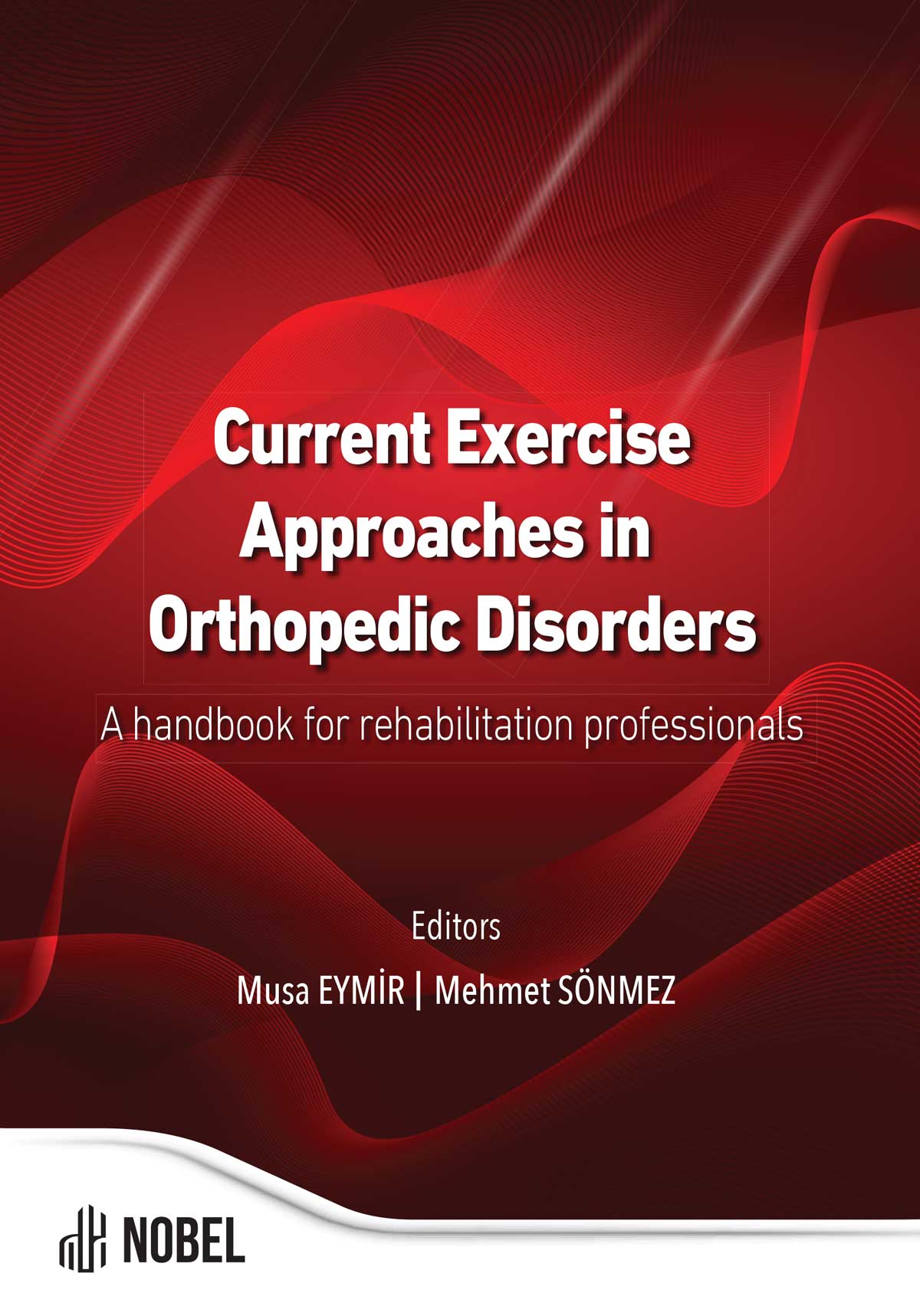Current Exercise Approaches for Common Knee Pathologies
Musa Eymir (Author), Nilsah Yilmaz (Author)
Release Date: 2024-01-18
The knee is a complex structure subjected to heavy repetitive loads. It is no surprise that the joint is frequently injured, prompting the need for expert advice on how to rehabilitate it. The optimum treatment of knee injuries depends on thoroughly examining the anatomy and biomechanics to identify structural and functional impairments. In rehabilitation, any [...]
Media Type
PDF
Buy from
Price may vary by retailers
| Work Type | Book Chapter |
|---|---|
| Published in | Current Exercise Approaches in Orthopedic Disorders A Handbook for Rehabilitation Professionals |
| First Page | 231 |
| Last Page | 258 |
| DOI | https://doi.org/10.69860/nobel.9786053358770.8 |
| ISBN | 978-605-335-877-0 (PDF) |
| Language | ENG |
| Page Count | 28 |
| Copyright Holder | Nobel Tıp Kitabevleri |
| License | https://nobelpub.com/publish-with-us/copyright-and-licensing |
Musa Eymir (Author)
Asst. Prof. Dr., Erzurum Technical University
https://orcid.org/0000-0002-9671-9583
3The author received his undergraduate degree in Physical Therapy and Rehabilitation at Hacettepe University 2008, his master’s degree in Orthopedic Physiotherapy at Dokuz Eylül University in 2016, and his doctorate from the Department of Physical Therapy and Rehabilitation at Dokuz Eylül University in 2021.
The author worked as a Physiotherapist at different Special Education and Rehabilitation centers from 2008 to 2014. He started to study in academia in 2014 and as a Research Assistant at the School of Physical Therapy and Rehabilitation at Dokuz Eylül University between 2014 and 2021. In June 2021, he started to study as a Research Assistant at the Department of Physical Therapy and Rehabilitation at Erzurum Technical University. By September 2021, he was promoted to Assistant Professor Doctor within the same university and department, where he continues his professional academic life.
Nilsah Yilmaz (Author)
M.Sc. PT, Tokat Gaziosmanpasa University
https://orcid.org/0000-0002-3044-3326
3She completed his bachelor degree at Gazi University. She completed his Master of Science (2020) in the Department of Physical Therapy and Rehabilitation at the Başkent University. In 2020, she started her doctorate education at Gazi University, Department of Physiotherapy and Rehabilitations. Her graduate field of study is “Children with Cerebral Palsy with Drooling”. She worked as a physiotherapist in a special education and rehabilitation center between 2017-2020. Now, she is currently working as a lecturer at Tokat Gaziosmanpaşa University. She has clinical and academic publication experience in the fields of pediatrics and musculoskeletal pain in athletes. She has 7 years of experience in the clinic and teaches sports medicine and orthotics at undergraduate level. She is doing her PhD on kinesio taping. Her main research focus is on “cerebral palsy”, “kinesio taping” and “musculoskeletal pain”.
Abulhasan, J. F., & Grey, M. J. (2017). Anatomy and physiology of knee stability. Journal of Functional Morphology, 2(4), 34.
Anwer, S., Li, H., Anwar, D., & Wong, A. Y. L. (2024). Chapter 37 - Biomechanical principles of exercise prescription in knee rehabilitation. In A. R. Nochehdehi, F. Nemavhola, S. Thomas, & H. J. Maria (Eds.), Cartilage Tissue and Knee Joint Biomechanics (pp. 617-631): Academic Press
Clark, N., & Herrington, D. L. (2010). The knee. In P. Comfort & E. Abrahamson (Eds.), Sport rehabilitation and injury prevention (pp. 407-463). Chichester: Wiley-Blackwell
Gella, S., Whelan, D. B., Stannard, J. P., & MacDonald, P. B. (2015). Acute Management and Surgical Timing of the Multiligament-injured Knee. Instr Course Lect, 64, 521-530.
Johnson, M. (2011). The Knee. In F. Wilson, J. Gormley, & J. Hussey (Eds.), Exercise Therapy in the Management of Musculoskeletal Disorders (pp. 159-186). London: Wiley-Blackwell.
Kaya, D., Calik, M., Callaghan, M. J., Yosmaoglu, B., & Doral, M. N. (2018). Proprioception After Knee Injury, Surgery and Rehabilitation. In D. Kaya, B. Yosmaoglu, & M. N. Doral (Eds.), Proprioception in Orthopaedics, Sports Medicine and Rehabilitation (pp. 123-142). Cham: Springer International Publishing
Kisner, C., Colby, L. A., & Borstad, J. (2017). Therapeutic exercise: foundations and techniques. Philadelphia: Fa Davis.
Margo, B. J., Radnay, C. S., & Scuderi, G. R. (2010). Anatomy of the Knee. Singapore: World Scientific Publishing Co.Pe.Ltd.
Micheo, W., Rodríguez-Santiago, B., Sepulveda-Irizarry, F., & Castillo, B. (2021). Knee injuries. In G. Miranda-Comas, G. Cooper, J. Herrera, & S. Curtis (Eds.), Essential Sports Medicine: A Clinical Guide for Students and Residents (pp. 315-340): Springer International Publishing.
Wang, H., Liu, B., Qi, X., Woo, S. L.-Y., & Cheng, C.-K. (2020). Biomechanics of the Knee. In C.-K. Cheng & S. L. Y. Woo (Eds.), Frontiers in Orthopaedic Biomechanics (pp. 189-218). Singapore: Springer Nature Singapore
Wilson, F. (2011). The Role of Exercise in Managing Musculoskeletal Disorders. In F. Wilson, J. Gormley, & J. Hussey (Eds.), Exercise Therapy in the Management of Musculoskeletal Disorders (pp. 6-18). London: Wiley-Blackwell.
| onix_3.0::thoth | Thoth ONIX 3.0 |
|---|---|
| onix_3.0::project_muse | Project MUSE ONIX 3.0 |
| onix_3.0::oapen | OAPEN ONIX 3.0 |
| onix_3.0::jstor | JSTOR ONIX 3.0 |
| onix_3.0::google_books | Google Books ONIX 3.0 |
| onix_3.0::overdrive | OverDrive ONIX 3.0 |
| onix_2.1::ebsco_host | EBSCO Host ONIX 2.1 |
| csv::thoth | Thoth CSV |
| json::thoth | Thoth JSON |
| kbart::oclc | OCLC KBART |
| bibtex::thoth | Thoth BibTeX |
| doideposit::crossref | CrossRef DOI deposit |
| onix_2.1::proquest_ebrary | ProQuest Ebrary ONIX 2.1 |
| marc21record::thoth | Thoth MARC 21 Record |
| marc21markup::thoth | Thoth MARC 21 Markup |
| marc21xml::thoth | Thoth MARC 21 XML |

